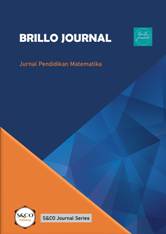An Analysis of Grade VIII Students' Difficulties in Solving Circle Story Problems: A Study Based on Polya's Problem-Solving Theory
DOI:
https://doi.org/10.56773/bj.v4i2.70Keywords:
Circle story problems, Difficulty solving problems, Polya's theoryAbstract
This study aims to explore the difficulties experienced by students of grade VIII of junior high school in solving circle story problems based on Polya's Theory. The research approach used is a qualitative approach. This type of research is qualitative descriptive research. This research was conducted in one of the junior high schools in North Central Timor Regency. The subjects of this study were grade VIII consisting of 20 students. The instruments used were 4 circle material test questions and interviews to determine the factors that cause students to have difficulty working on the questions. Data analysis techniques through the stages of test data analysis, data reduction, data display and conclusion drawing. The results of this study indicate that the difficulties faced by students are 1) difficulty understanding the problem, namely students have difficulty in positioning the function of the symbol on the known and asked parts of the question, 2) difficulty making a solution plan, namely students have difficulty connecting the known and asked elements so that students do not fully understand the strategy that will be used to plan the solution, 3) difficulty completing the solution plan, namely students have difficulty writing a complete formula to be used in solving the problem so that they do not find the results requested by the question, 4) difficulty re-checking, namely students do not know how to make conclusions from the results of their work.
References
Dwi, D. F., & Audina, R. (2021). Analisis Faktor Penyebab Kesulitan Belajar Matematika Kelas IV Sekolah Dasar Negeri. Cybernetics: Journal Educational Research and Social Studies, 2(3), 94–106. https://doi.org/10.51178/cjerss.v2i3.256
Enlisia, A. P., Rahardjo, S., & Sisworo, S. (2020). Kesulitan Siswa Dalam Menyelesaikan Masalah Matematika Berdasarkan Langkah Polya. Jurnal Pendidikan: Teori, Penelitian, Dan Pengembangan, 5(12), 1820–1826. https://doi.org/10.17977/jptpp.v5i12.14347
Hafid, H., Kartono, K., & Suhito, S. (2017). Remedial Teaching untuk Mengatasi Kesulitan Belajar Siswa pada Kemampuan Pemecahan Masalah Matematika berdasarkan Prosedur Newman. Unnes Journal of Mathematics Education, 5(3), 257–265. https://doi.org/10.15294/ujme.v5i3.12310
Kholil, M., & Zulfiani, S. (2020). Faktor-Faktor Kesulitan Belajar Matematika Siswa Madrasah Ibtidaiyah Da’watul Falah Kecamatan Tegaldlimo Kabupaten Banyuwangi. EDUCARE: Journal of Primary Education, 1(2), 151–168. https://doi.org/10.35719/educare.v1i2.14
Mawaddah, S., & Anisah, H. (2015). Kemampuan Pemecahan Masalah Matematis Siswa Pada Pembelajaran Matematika dengan Menggunakag) di SMPn Model Pembelajaran Generatif (Generative Learning) di SMP. EDU-MAT: Jurnal Pendidikan Matematika, 3(2), 166–175. https://doi.org/10.20527/edumat.v3i2.644
Miles, M. B., & Huberman, A. M. (1984). Qualitative data analysis: A sourcebook of new methods. Beverly Hills.
Nurcholis, R. A., & Istiningsih, G. (2021). Problematika dan Solusi Program Literasi Baca-Tulis Siswa Kelas Rendah di SD Negeri Butuh. Jurnal Ilmiah Profesi Pendidikan, 6(2), 189–195. https://doi.org/10.29303/jipp.v6i2.206
Nurmaya, R., Muzdalipah, I., & Heryani, Y. (2022). Analisis proses literasi matematis siswa dalam menyelesaikan soal model asesmen kompetensi minimum. Teorema: Teori Dan Riset Matematika, 7(1), 13–26. https://doi.org/10.25157/teorema.v7i1.6378
Nursalam, N. (2016). Diagnostik kesulitan belajar matematika: Studi pada siswa SD/MI di Kota Makassar. Lentera Pendidikan : Jurnal Ilmu Tarbiyah Dan Keguruan, 19(1), 1–15. https://doi.org/10.24252/lp.2016v19n1a1
Polya, G. (1957). How To Solve It: A New Aspect of Mathematical Method. Princeton University Press.
Raudho, Z., Handayani, T., & Syutaridho, S. (2020). Analisis Kemampuan Pemecahan Masalah Soal Pytagoras Berdasarkan Langkah-Langkah Polya. Suska Journal of Mathematics Education, 6(2), 101. https://doi.org/10.24014/sjme.v6i2.9061
Rofiqi, R., & Rosyid, M. Z. (2020). Diagnosis Kesulitan Belajar pada Siswa. Literasi Nusantara.
Septiahani, A., Melisari, & Zanthy, L. S. (2020). Analisis Kesalahan Siswa SMK dalam Menyelesaikan Soal Materi Barisan dan Deret. Mosharafa: Jurnal Pendidikan Matematika, 9(2), 311–322. https://doi.org/10.31980/mosharafa.v9i2.613
Son, A L, Darhim, D., & Fatimah, S. (2019). An analysis to student error of algebraic problem solving based on polya and newman theory. Journal of Physics: Conference Series, 1315(1), 012069. https://doi.org/10.1088/1742-6596/1315/1/012069
Son, A. L., Darhim, D., & Fatimah, S. (2020). Students’ mathematical problem-solving ability based on teaching models intervention and cognitive style. Journal on Mathematics Education, 11(2), 209–222. https://doi.org/10.22342/jme.11.2.10744.209-222
Yasin, M., & Netriwati, N. (2019). Analisis Kesulitan Belajar : Dampak Latar Belakang Kejuruan ditinjau dari Proses Pembelajaran Matematika Perguruan Tinggi. Desimal: Jurnal Matematika, 2(1), 59–67. https://doi.org/10.24042/djm.v2i1.2040
Yuwono, T., Supanggih, M., & Ferdiani, R. D. (2018). Analisis Kemampuan Pemecahan Masalah Matematika dalam Menyelesaikan Soal Cerita Berdasarkan Prosedur Polya. Jurnal Tadris Matematika, 1(2), 137–144. https://doi.org/10.21274/jtm.2018.1.2.137-144
Downloads
Published
How to Cite
Issue
Section
License
Copyright (c) 2025 Septianingsi Manekat, Aloisius Loka Son, Meiva Marthaulina Lestari Siahaan

This work is licensed under a Creative Commons Attribution 4.0 International License.
The authors agree that this article remains permanently open access under the terms of the Creative Commons Attribution 4.0 International License




